Related Research Articles
The Cod Wars were a series of 20th-century confrontations between the United Kingdom and Iceland about fishing rights in the North Atlantic. Each of the disputes ended with an Icelandic victory.

The Arctic Corsair(H320) is a deep-sea trawler, built in 1960, that was converted to a museum ship in 1999. She is temporarily berthed at Alexandra Dock in Kingston upon Hull, England, pending completion of a new permanent location in the city's Museums Quarter. Exhibits and guides aboard the boat tell the story of Hull's deep-sea fishing industry.
The fishing vessel Gaul was a deep sea factory ship based at Hull, United Kingdom. She was launched in December 1971 by Brooke Marine of Lowestoft, entering service during 1972 with the Ranger Fishing company, where she was registered at North Shields as Ranger Castor, SN18. She was renamed when Ranger Fishing was bought by British United Trawlers and re-registered at Hull as Gaul, H243. She sank some time on the night of 8–9 February 1974 in storm conditions in the Barents Sea, north of Norway. No distress signal was received and her loss was not realised until 10 February after she twice failed to report in. An extensive search operation was launched but no trace of the ship was found, apart from a lifebuoy recovered three months later. All thirty-six crew were lost. The president of the British Trawler Federation described the loss of the Gaul as "the worst ever single-trawler tragedy". The wreck was finally located in 1997.

Concordia was a steel-hulled barquentine that was built in Poland in 1992 for the West Island College, Montreal, Canada. She served as a sail training ship until she capsized and sank on 17 February 2010.
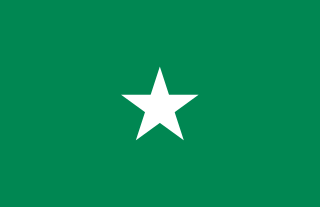
The Ross Group was a British food company founded in Grimsby, England in 1920.
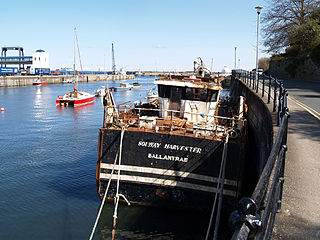
The Solway Harvester was a scallop dredger from Kirkcudbright, Scotland which sank off the coast of Douglas, Isle of Man in heavy seas on 11 January 2000 with the loss of all seven crew members. Following salvage, the damaged ship was taken to Douglas, where she remained until dismantled for scrap in January 2014.

A lifeboat or liferaft is a small, rigid or inflatable boat carried for emergency evacuation in the event of a disaster aboard a ship. Lifeboat drills are required by law on larger commercial ships. Rafts (liferafts) are also used. In the military, a lifeboat may double as a whaleboat, dinghy, or gig. The ship's tenders of cruise ships often double as lifeboats. Recreational sailors usually carry inflatable liferafts, though a few prefer small proactive lifeboats that are harder to sink and can be sailed to safety.
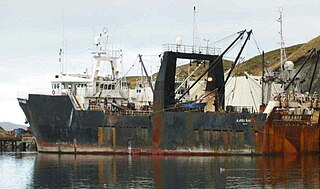
FV Alaska Ranger was a fishing factory ship owned and operated by the Fishing Company of Alaska of Seattle, Washington. The ship was constructed in 1973 for use as an oil field service vessel. The ship sank 23 March 2008, after reporting progressive flooding only hours earlier. Of the 47 on board, 42 were rescued. Of the five fatalities, four were recovered dead, and one was never found. The Coast Guard was initially misinformed about the number of persons on board the vessel, and secured the search with one crew member still unaccounted for. After realizing there was still one person missing, the Coast Guard reinstated the search, but did not find the crew member.

The Viola is a steam trawler built in 1906 in Hull. She is the oldest surviving steam trawler in the world. During her long career, she was known as HMTViola, Kapduen, and Dias. She is currently beached at Grytviken in South Georgia, though there are currently plans afoot to return her to Hull.
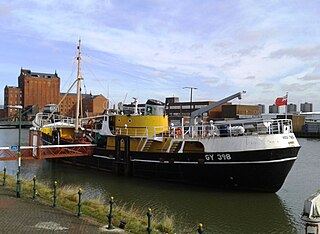
Ross Tiger is a traditional side-winder fishing trawler that was converted into a museum ship in 1992. She is currently berthed in Alexandra Dock at her home port of Grimsby, close to the site of the former PS Lincoln Castle. She forms the star attraction of North East Lincolnshire County Council's National Fishing Heritage Centre since restored and opened to the public in 1992. As Grimsby's last traditional sidewinder 'conventional trawler', she represents a now virtually extinct breed of vessels that once made up the largest fishing fleet in the world.
The Sparta is a 48-metre (157-foot) Russian-flagged fishing trawler and refrigerator ship.

HM Trawler Alvis was a British trawler that was taken up from trade and used by the Royal Navy during the Second World War. She was returned to the fishing industry at the end of hostilities in 1945.
The Russian-flagged fishing trawler Dalniy Vostok sank on 1 April 2015, off Russia's Kamchatka Peninsula in the Sea of Okhotsk. Fifty-seven of the ship's 132 crew members were confirmed dead, with rescue operations underway for survivors. The freezer trawler sank 183 nautical miles west of Krutogorovsky, a settlement in Kamchatka's Sobolevsky District.
Lillian Bilocca was a British fisheries worker and campaigner for improved safety in the fishing fleet as leader of the "headscarf revolutionaries" – a group of fishermen's family members. Spurred into action by the Hull triple trawler tragedy of 1968 which claimed 58 lives, she led a direct action campaign to prevent undermanned trawlers from putting to sea and gathered 10,000 signatures for a petition to Harold Wilson's government to strengthen safety legislation. She threatened to picket Wilson's house if he did not take action. Government ministers later implemented all of the measures outlined in the charter.

Mary Denness was a British ship's steward and fisherman's wife. She helped to lead a campaign that led to improvements in the safety of fishing trawlers following the 1968 Hull triple trawler tragedy. Denness afterwards served as a school nurse and was a matron at Eton College.
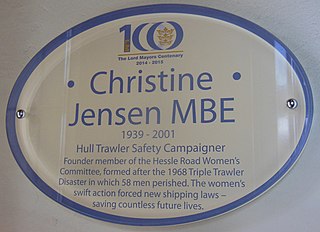
Christine Dorothy Jensen, MBE (1939–2001) was a British safety campaigner. She helped to lead a campaign that led to improvements in the safety of fishing trawlers following the 1968 Hull triple trawler tragedy, in which her brother was killed. Jensen later served on the committee of the British Fishermen's Association and founded a fishing heritage organisation. She was appointed a Member of the Order of the British Empire in 2000.

Yvonne Blenkinsop was a British woman known for her campaign to improve safety in the offshore fishing industry following the 1968 Hull triple trawler tragedy. She became only the third woman in 130 years to be awarded the freedom of the city of Hull in 2018.
The Arctic Viking(H452) was a British trawler ship that sailed from the Port of Hull in the East Riding of Yorkshire, England. Whilst the vessel was originally a commercial fishery ship, she also served as an anti-submarine vessel during the Second World War where she was sunk by enemy action. She was later involved in the Cod Wars, being actually targeted by a vessel from the Icelandic Navy. Besides her wartime service, she had two other accidents; one a collision in 1956 and another where she sank with the loss of five of her crew, 16 miles (26 km) off Flamborough Head in October 1961.

The Yorkshire coast fishery has long been part of the Yorkshire economy for centuries. The 114-mile (183 km) Yorkshire Coast, from the River Tees to the Humber estuary, has many ports both small and large where the fishing trade thrives. The historic ports at Hull and Whitby are important locations for the landing and processing of fish and shellfish. Scarborough and Bridlington are also sites of commercial fishing.
Harry Eddom is a former English trawlerman. He was the sole survivor of the Hull triple trawler tragedy which claimed the lives of 58 Hull sailors in January and February 1968.
References
- 1 2 "Triple trawler tragedy". BBC Humberside. 24 January 2008. Retrieved 11 September 2008.
- ↑ Creed 1998, pp. 19–31.
- ↑ "Trawler's Mayday call was held up 14 days". The Times . 10 October 1968. p. 2.
- ↑ Creed 1998, pp. 33–40.
- ↑ "Fjörutíu ár liðin frá sjóslysunum miklu í Ísafjarðardjúpi". vikari.is. Retrieved 1 December 2019.[ permanent dead link ]
- ↑ "Toll rises to 60 as third Hull trawler sinks". The Times. 6 February 1968. p. 1.
- ↑ Creed 1998, pp. 49–54.
- ↑ "Trawlermen's wives to try diplomacy". The Times. 3 February 1968. p. 1.
- ↑ "My Learning" . Retrieved 19 November 2020.
- ↑ "Check on trawler stability". The Times. 5 November 1968. p. 2.
- ↑ Creed 1998, pp. 79–84.
- ↑ "Hansard". Parliamentary Debates (Hansard) . 7 February 1986. Retrieved 11 September 2008.
- ↑ "Rækjubaujan á Ross Cleveland slitnaði upp". Vestfirska fréttablaðið (in Icelandic). 27 August 1992. Retrieved 20 September 2024.
- ↑ "BBC Inside Out finds lost Hull trawler after 34 years" . Retrieved 10 September 2008.
- ↑ "Hull trawler tragedy 50th anniversary marked with service". BBC News. 4 March 2018. Retrieved 4 March 2018.